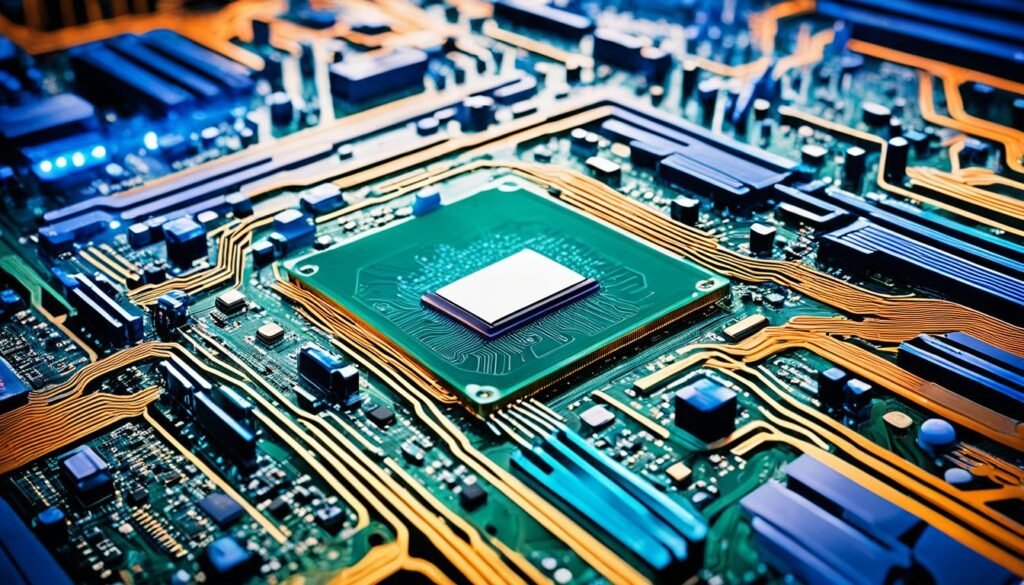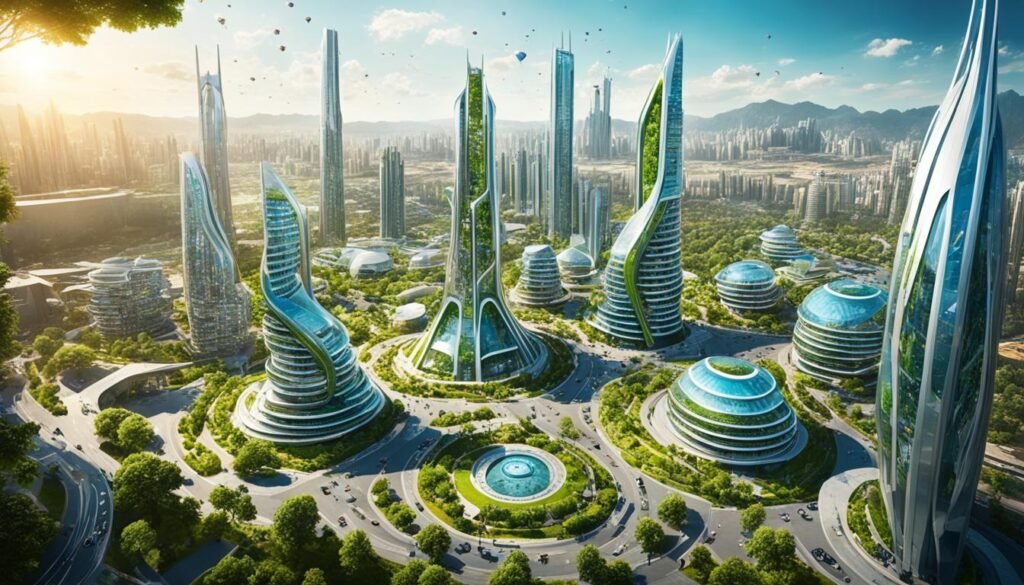Shaping Geopolitical Balance ,the semiconductor industry is a driving force behind both geopolitical balance and global economic growth. With a projected market size of $1 trillion by 2030, this industry’s significance cannot be overstated. From the automotive and aerospace sectors to defense, healthcare, and emerging technologies like AI and 5G, semiconductors have become essential components in various industries.
However, the concentration of semiconductor manufacturing in specific regions, including the US, Japan, and Taiwan, raises concerns about geopolitical risks and challenges. Complex global supply chains further exacerbate these issues. Recent shortages of semiconductors and the resulting geopolitical tensions between the US, China, and Taiwan have highlighted the need for self-reliance and strategic cooperation in the industry.
Key Takeaways:
- The semiconductor industry is crucial for geopolitical balance and global economic growth.
- Market size is expected to reach $1 trillion by 2030.
- Semiconductors are used in various sectors, including automotive, aerospace, defense, healthcare, and emerging technologies.
- Supply chain concentration and complexity pose risks and challenges.
- The shortage of semiconductors has led to geopolitical tensions and highlighted the need for self-reliance and strategic cooperation.
The Significance of Semiconductors in the Global Economy
Semiconductors are the linchpin of the modern technological landscape, contributing to the growth of the global economy. The semiconductor market plays a vital role in driving economic growth across various industries, including automotive, healthcare, telecommunications, and more.
The demand for advanced technologies like artificial intelligence (AI), 5G, and quantum computing has been fueling the growth of the semiconductor market. These technologies have far-reaching implications and are transforming industries, enabling innovative solutions, and enhancing productivity.
“Semiconductors are at the heart of the digital revolution, driving innovation and economic growth in a wide range of sectors.”
The semiconductor market is projected to reach $1 trillion by 2030, according to industry experts. This forecast reflects the increasing reliance of businesses and consumers on semiconductor-based products and services.
However, the semiconductor industry has faced significant challenges in recent years, with the global shortage of semiconductor chips disrupting supply chains and affecting the production of consumer goods such as smartphones, laptops, and automobiles.
To address these challenges and meet the growing demand, governments and companies worldwide are investing in semiconductor research and development (R&D) and manufacturing capabilities.
By establishing domestic semiconductor manufacturing capabilities, countries strive to attain self-sufficiency, reduce dependency on foreign suppliers, and gain a competitive advantage in the global market.
Investments in semiconductor R&D and manufacturing have a positive impact on job creation, technological advancement, and overall economic growth. The semiconductor industry not only provides direct employment opportunities but also drives demand for related industries, contributing to a thriving ecosystem.
Key Industries Benefiting from Semiconductors
- Automotive: Semiconductors play a pivotal role in advanced driver assistance systems, electric vehicle technologies, and connected car solutions.
- Healthcare: Medical devices and equipment heavily rely on semiconductor technology, enabling precise diagnosis, treatment, and monitoring.
- Telecommunications: 5G technology and network infrastructure heavily depend on semiconductors, enabling faster data transmission, enhanced connectivity, and the Internet of Things (IoT).
- Consumer Electronics: Smartphones, laptops, wearable devices, and home appliances leverage semiconductors to deliver cutting-edge features and functionalities.
- Industrial Automation: Semiconductors enable automation and control systems, optimizing manufacturing processes, and improving operational efficiency.
As the world becomes increasingly connected and reliant on advanced technologies, the significance of semiconductors in driving the global economy will continue to grow. Governments, industry players, and stakeholders must collaborate to overcome challenges, foster innovation, and ensure a robust semiconductor ecosystem that supports sustained economic growth.
Geopolitical Challenges in the Semiconductor Industry
The semiconductor industry is currently facing numerous geopolitical challenges that are impacting global supply chains and trade dynamics. The ongoing geopolitical tensions between major players like the US, China, and Taiwan have exacerbated these challenges, resulting in disruptions and shortages of semiconductors.
The US-China trade war, in particular, has led to trade barriers and export-control measures, creating an unstable environment for semiconductor manufacturers. These restrictions have disrupted global supply chains, affecting the availability of semiconductors for various industries, including automotive, consumer electronics, and telecommunications.
In response to these challenges, countries are increasingly emphasizing self-reliance and domestic manufacturing to achieve greater supply chain resilience. By reducing dependence on a limited number of players in the supply chain, countries aim to mitigate the risks associated with geopolitical tensions and trade disputes.
The need for self-reliance in the semiconductor industry has become more apparent in recent years. The reliance on a small number of countries for semiconductor manufacturing has highlighted the vulnerability of global supply chains to geopolitical tensions. To enhance their self-reliance, governments and companies are investing in the development of domestic semiconductor manufacturing capabilities.
“The geopolitical challenges faced by the semiconductor industry highlight the need for diversification and strategic cooperation. By diversifying the supply chain and fostering international collaboration, the industry can reduce the impact of geopolitical tensions and build a more resilient ecosystem.”
In addition to diversifying supply chains, strategic cooperation is key to addressing the geopolitical challenges in the semiconductor industry. Collaboration between governments, companies, and international institutions can help promote stability and fair competition. This cooperation can involve information sharing, talent development, and the establishment of industry standards.
The semiconductor industry plays a critical role in the global economy, and geopolitical challenges have far-reaching implications. It is crucial for stakeholders to navigate these challenges and work together to ensure the stability and growth of the industry.
![]()
Key Points:
- Geopolitical tensions are disrupting global supply chains in the semiconductor industry.
- The US-China trade war and export-control measures have led to shortages of semiconductors.
- Self-reliance and domestic manufacturing are being emphasized to mitigate risks and vulnerabilities.
- Diversification and strategic cooperation are essential for addressing geopolitical challenges.
- The industry’s stability and growth depend on navigating these challenges effectively.
The Geopolitical Implications of Semiconductor Supply Chain Disruptions
Semiconductor supply chain disruptions have significant geopolitical implications, particularly in the realm of national security and military technology. The US-China-Taiwan tensions and the shortage of semiconductors have brought attention to the vulnerability of global supply chains and their impact on critical industries.
The semiconductor industry plays a crucial role in developing advanced military technologies. Disruptions in the supply chain can hamper a country’s defense capabilities, posing risks to national security. Geopolitical tensions and competition between major powers further exacerbate the challenges.
These disruptions have prompted governments to reevaluate their strategic interests in the semiconductor industry. Many countries are now investing in domestic semiconductor manufacturing to reduce dependence on foreign suppliers and ensure the resilience of their supply chains.
| Geopolitical Implications of Semiconductor Supply Chain Disruptions | |
|---|---|
| National Security | Disruptions in the semiconductor supply chain can compromise a country’s defense capabilities. |
| Military Technology | The semiconductor industry plays a crucial role in developing advanced military technologies. |
| Geopolitical Tensions | Competition between major powers and geopolitical tensions heighten the risks of supply chain disruptions. |
By investing in domestic semiconductor manufacturing, governments aim to enhance their national security, protect critical industries, and reduce the risks associated with geopolitical tensions. This strategic shift is expected to shape the future of the semiconductor industry and its geopolitical landscape.
Government Intervention and the Future of Semiconductor Manufacturing
Governments around the world are recognizing the strategic importance of the semiconductor industry and are intervening to address supply chain vulnerabilities and bolster domestic manufacturing capabilities. Countries like the United States and China are investing heavily in semiconductor research and development (R&D), as well as manufacturing, to enhance their technological capabilities and reduce dependence on foreign suppliers. This government intervention is driven by the recognition of the industry’s critical role in protecting national security interests and fostering economic growth.
The focus on domestic manufacturing is motivated by the need to secure the semiconductor supply chain and maintain a competitive edge in global markets. By promoting the growth of domestic semiconductor manufacturing, governments aim to reduce reliance on foreign suppliers and minimize the risks associated with complex global supply chains. This approach aligns with the strategic interests of countries seeking to maintain technological sovereignty and reduce vulnerabilities in critical industries.
Government support, funding, and strategic policies play a crucial role in shaping the future of semiconductor manufacturing. Financial incentives, tax breaks, and research grants are provided to encourage investment in semiconductor R&D and the construction of state-of-the-art manufacturing facilities. In addition, governments are working alongside industry stakeholders to establish industry standards, promote innovation, and foster collaboration.
“Government intervention is crucial in driving the development of the semiconductor industry. Strategic investments and policies support the growth of domestic manufacturing, enhance national security, and ensure a competitive edge in the global market.”
The Role of International Cooperation
International cooperation is also essential for the sustainable growth of the semiconductor industry. Collaborative efforts among countries can help establish common standards, share information, and address common challenges related to supply chain disruptions and intellectual property rights. Moreover, international cooperation can foster fair competition and stimulate innovation, benefiting both established players and emerging economies.
Furthermore, the development of sustainable technologies is a priority for the semiconductor industry. Energy efficiency and environmental concerns are driving the industry to explore new materials and designs. Compound semiconductors, such as silicon carbide and gallium nitride, offer improved energy efficiency and reduced carbon footprints. Governments and industry leaders are investing in the research and development of sustainable semiconductor technologies to ensure a greener future.
Government Intervention in Action: The Examples of the United States and China
The United States and China are among the countries at the forefront of government intervention in the semiconductor industry. The United States has launched initiatives like the CHIPS for America Act and the National Semiconductor Technology Center to strengthen its domestic manufacturing capabilities. These programs aim to increase investment in semiconductor R&D, improve supply chain resilience, and enhance national security.
China, on the other hand, has introduced the Made in China 2025 policy, which prioritizes the development of key technologies, including semiconductors. The government has committed significant funding to support domestic semiconductor manufacturing and reduce China’s reliance on foreign suppliers. China’s push for self-sufficiency in semiconductors is driven by its strategic interests in maintaining technological sovereignty and economic competitiveness.
![]()
In conclusion, government intervention plays a crucial role in shaping the future of the semiconductor manufacturing industry. Governments worldwide are investing in domestic manufacturing, enhancing supply chain resilience, and fostering international cooperation. By aligning strategic interests, governments and industry stakeholders can secure the semiconductor supply chain, protect national security, and drive economic growth. Furthermore, the development of sustainable technologies and international collaboration are essential for the industry’s long-term success.
The Role of International Cooperation in the Semiconductor Industry
International cooperation plays a crucial role in ensuring the resilience of the semiconductor industry and maintaining global supply chain stability. The complexity and interconnectedness of the industry require collaboration among countries, companies, and international institutions. By working together, stakeholders can address common challenges, foster innovation, and promote industry standards.
Cooperation in the semiconductor industry goes beyond mere information sharing. It involves strategic partnerships to develop supply chain resilience and mitigate risks like supply chain disruptions and intellectual property rights. Collaborative efforts allow stakeholders to pool resources, expertise, and best practices, enhancing the overall competitiveness of the industry.
One area where international cooperation is particularly important is standard-setting. Given the global nature of the semiconductor market, harmonized standards ensure compatibility and interoperability across different devices and systems. This allows for seamless integration and enhances the efficiency of global supply chains.
Moreover, international cooperation plays a crucial role in talent development. By promoting cross-border collaboration, countries can facilitate the exchange of knowledge and expertise, filling skill gaps and fostering a well-trained workforce. This helps the semiconductor industry stay at the forefront of technological advancements and maintain its competitive edge in the global market.
The Benefits of International Cooperation in the Semiconductor Industry
International cooperation brings several benefits to the semiconductor industry:
- Promotes supply chain resilience: By collaborating on supply chain management and diversification strategies, stakeholders can minimize the impact of disruptions and ensure a steady flow of critical components.
- Fosters fair competition: Through international cooperation, countries can establish a level playing field, promoting fair competition and preventing monopolistic practices.
- Drives innovation: The exchange of ideas, technological advancements, and research collaboration that comes with international cooperation fosters innovation in the semiconductor industry.
- Enhances industry standards: Collaboration on standards development ensures compatibility and interoperability, driving greater efficiency and reducing costs in the global supply chain.

| Benefits of International Cooperation | Explanation |
|---|---|
| Promotes supply chain resilience | Collaboration helps in diversifying supply chains, reducing vulnerabilities, and ensuring a stable supply of semiconductors. |
| Fosters fair competition | International cooperation prevents monopolistic practices and encourages healthy competition within the semiconductor industry. |
| Drives innovation | The exchange of ideas and collaboration on research sparks innovation, pushing the boundaries of semiconductor technology. |
| Enhances industry standards | Working together on standards development promotes compatibility and efficiency, benefiting the entire semiconductor ecosystem. |
Through international cooperation, the semiconductor industry can navigate the challenges of a globalized market, foster innovation, and contribute to sustainable economic growth. As geopolitical tensions persist, collaborative efforts become even more critical in maintaining a stable and resilient semiconductor ecosystem.
The Race for Technological Dominance and the Shifting Geopolitical Landscape
The semiconductor industry is currently leading the race for technological dominance, and this pursuit is significantly shaping the geopolitical landscape. Key players in the industry, including the United States, China, and Taiwan, are actively investing in semiconductor research, development, and manufacturing to gain a competitive edge in the global market.
The rapidly evolving geopolitical landscape, characterized by trade tensions and the quest for self-sufficiency, is reshaping global alliances and trade partnerships. The semiconductor industry’s increasing significance is not only transforming the dynamics of global politics but also influencing the future of the global economy.
Emerging economies such as India, Indonesia, and Malaysia are strategically positioning themselves to seize opportunities and establish a strong presence in the semiconductor industry. These countries recognize the potential of the industry as a catalyst for economic growth and technological advancement. As they navigate through the highly competitive global market, these emerging economies are set to contribute significantly to the industry’s expansion and enhance their geopolitical influence.
As the balance of power continues to shift, the semiconductor industry’s pivotal role in shaping the future of global politics and economics becomes increasingly evident. Technological dominance has emerged as a critical factor in determining geopolitical influence, driving countries to prioritize investments in semiconductor technologies and fostering a highly competitive environment.

In such a landscape, global competition intensifies as nations strive to secure their positions as key players in the industry. The race for technological dominance fuels innovation, drives economic growth, and widens the scope of international cooperation and collaboration. The semiconductor industry acts as a catalyst, propelling nations to strengthen their technological capabilities, overcome supply chain vulnerabilities, and shape the future of global trade dynamics.
As the race for technological dominance unfolds, it is crucial for countries to navigate geopolitical complexities, foster international cooperation, and establish robust strategic policies. Only with these measures can nations effectively address shared challenges, embrace sustainable growth, and leverage the full potential of the semiconductor industry to drive economic prosperity and advance global interests.
Challenges and Opportunities for Emerging Economies in the Semiconductor Industry
Emerging economies such as India, Indonesia, and Malaysia are recognizing the immense potential of the semiconductor industry to drive economic growth and foster technological advancement. These countries are strategically leveraging their engineering talent, government support, and evolving technology ecosystems to attract investments and promote domestic semiconductor manufacturing. Initiatives like India’s National Electronics Policy and the Indian Semiconductor Mission are aimed at establishing India as a hub for electronics system design and manufacturing.
However, emerging economies face their fair share of challenges in navigating the semiconductor industry. One of the key challenges is attracting capital investment for infrastructure development and research and development activities. Building semiconductor fabrication facilities requires substantial financial resources, and emerging economies need to demonstrate their potential and attractiveness to investors.
Talent development is another critical challenge. The semiconductor industry demands skilled engineers and technicians proficient in disciplines like electrical engineering, materials science, and computer science. Emerging economies must invest in educational programs and initiatives to nurture and develop a strong talent pool to support the growth and sustainability of their semiconductor industry.
Compliance with international regulations is also a significant consideration for emerging economies looking to establish themselves in the semiconductor industry. Adhering to intellectual property rights, export control regulations, and environmental standards requires an understanding of global trade frameworks and legal frameworks.
Despite these challenges, emerging economies possess immense potential to become major contributors to the global semiconductor market. With the right strategic investments, talent development initiatives, and adherence to international regulations, these countries can leverage their unique advantages to attract investment, foster domestic semiconductor manufacturing, and position themselves as competitive players on the global stage.

Emerging economies see the semiconductor industry as a catalyst for economic growth and technological advancement.
Sustainable Technologies and the Future of Semiconductor Manufacturing
As the semiconductor industry continues to grow, there is a growing emphasis on sustainable technologies and addressing environmental concerns. With the increasing demand for energy-efficient solutions, the industry is exploring various strategies to reduce its carbon footprint and enhance energy efficiency across different sectors.
One approach is through the development of energy-efficient chip designs. These designs optimize power consumption, allowing devices to operate at lower energy levels without compromising performance. By implementing energy-efficient chips in electronic devices, industries can reduce their energy consumption and contribute to a more sustainable future.
“Energy-efficient chip designs are revolutionizing the semiconductor industry by offering environmentally friendly solutions that promote sustainability.”
Another avenue for sustainable semiconductor manufacturing is the utilization of compound semiconductors like silicon carbide and gallium nitride. These materials have properties that enable higher levels of energy efficiency compared to traditional silicon. For instance, silicon carbide has a higher breakdown voltage and thermal conductivity, making it suitable for power electronics applications that require high energy efficiency.
The semiconductor industry is not without its challenges in adopting sustainable practices. Supply chain disruptions, cybersecurity threats, and talent shortages can impact the industry’s ability to implement sustainable technologies effectively. However, overcoming these challenges and moving towards a sustainable future is crucial for the long-term growth and stability of the industry.
nato ,global financial ,european union ,bilateral,commodity,instability,trade and investment, escalation ,decouple,great power competition ,financial stability,global response,trade flows,world economy,trade partners,geopolitical events ,policy studies,global pandemic ,political and economic ,protectionism,complex geopolitical,measuring geopolitical ,geopolitical competition,heightened geopolitical.
To address these challenges and prioritize sustainability, collaboration between industry stakeholders is essential. Governments, semiconductor manufacturers, and research institutions need to work together to develop innovative solutions that reduce the industry’s environmental impact while maintaining technological advancements and economic growth.
Sustainable Technologies in Semiconductor Manufacturing
Several sustainable technologies are shaping the future of semiconductor manufacturing, including:
- Green semiconductor fabrication processes that minimize water and chemical usage
- Renewable energy sources to power semiconductor fabs and reduce carbon emissions
- Efficient waste management systems that promote recycling and reduce landfill waste
- Circular economy approaches that encourage the reuse and reintegration of semiconductor materials
Implementing these technologies requires a collective effort from industry leaders, policymakers, and consumers. By adopting sustainable practices, the semiconductor industry can mitigate environmental risks, contribute to global sustainability goals, and ensure a more efficient and responsible future.
| Sustainable Technology | Benefits |
|---|---|
| Green Semiconductor Fabrication Processes | Reduces water and chemical usage, minimizing environmental impact |
| Renewable Energy Sources | Decreases carbon emissions, promotes clean energy adoption |
| Efficient Waste Management Systems | Reduces landfill waste, encourages recycling and resource recovery |
| Circular Economy Approaches | Promotes the reuse and reintegration of semiconductor materials, reducing waste |
The Future of Sustainable Semiconductor Manufacturing
The development of sustainable technologies and responsible manufacturing practices is pivotal in shaping the future of semiconductor manufacturing. As the industry progresses, it must continue to innovate and implement strategies that address environmental concerns without compromising technological advancements.
Also Read:- Ukraine vs Russia Crisis ! Danger Of WW3?
By focusing on sustainability, the semiconductor industry can become a driving force for positive change, ensuring a greener and more energy-efficient world. Through collaboration, research, and the adoption of sustainable practices, the industry has the potential to lead the way towards a more sustainable future.
Conclusion
The semiconductor industry plays a pivotal role in shaping geopolitical balance and driving global economic growth. Its rapid growth, coupled with supply chain vulnerabilities and geopolitical tensions, has spurred governments and companies worldwide to invest in domestic manufacturing, enhance supply chain resilience, and foster international cooperation. As countries vie for technological dominance in the industry, the geopolitical landscape is undergoing significant shifts.
Emerging economies, such as India, Indonesia, and Malaysia, are capitalizing on the semiconductor industry as an opportunity for economic growth and technological advancement. By leveraging their engineering talent and government support, these countries are positioning themselves as major players in the global market.
As the industry continues to evolve, sustainability, collaboration, and strategic policies will be key considerations. Energy-efficient chip designs and responsible manufacturing practices are crucial for driving the industry’s future growth. International cooperation in areas such as standard-setting and addressing common challenges will foster innovation and mitigate geopolitical tensions. The semiconductor industry’s influence on the geopolitical landscape and its contribution to global economic growth will remain profound.
FAQs
Q: How is the semiconductor industry impacting geopolitical balance and economic growth?
A: The semiconductor industry plays a crucial role in shaping geopolitical balance as it is a critical component for various sectors and national security. Due to its global nature, it can influence economic growth and international relations.
Q: What impact do geopolitical risks have on the semiconductor industry?
A: Geopolitical risks such as trade tensions, regional conflicts, and sanctions can disrupt the supply chain, leading to market volatility and affecting the semiconductor industry’s operations.
Q: How has the COVID-19 pandemic affected the semiconductor industry globally?
A: The COVID-19 pandemic caused disruptions in supply chains, production delays, and shift in consumer demand, impacting the semiconductor industry on a global scale geopolitics.
Q: What role does the semiconductor industry play in the geopolitical landscape of 2022?
A: In 2022, the semiconductor industry is at the center of geopolitical discussions due to its significance in various sectors and its impact on national economies.
Q: How does fragmentation in the semiconductor industry affect global economic growth?
A: Fragmentation in the semiconductor industry can lead to inefficiencies, higher costs, and reduced innovation, impacting global economic growth and competitiveness,foreign policy.
Q: What measures are being taken to address the geopolitical challenges faced by the semiconductor industry?
A: Policymakers are working on strategies to mitigate geopolitical risks, enhance supply chain resilience, and promote collaboration among industry stakeholders to address the challenges faced by the semiconductor sector.
Q: How is the semiconductor industry navigating the balancing act between geopolitical dynamics and economic interests?
A: The semiconductor industry is balancing geopolitical considerations with economic interests by diversifying supply chains, engaging in dialogues with governments, and adapting to regulatory changes to ensure stability and growth,gdp.
Source Links
- https://kpmg.com/in/en/blogs/home/posts/2024/01/semiconductor-new-driver-of-geopolitical-balance.html
- https://carnegieendowment.org/files/Bhandari_-_India_Semiconductors_060723.pdf
- https://digitalcollections.sit.edu/cgi/viewcontent.cgi?article=4616&context=isp_collection




